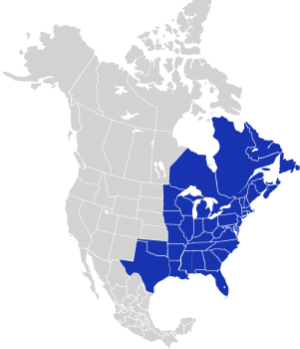Partners in Flight Eastern Working Group
species
(0)
habitats
(0)
organizations
(10)
Blackpoll Warbler Focus Group, Canada Warbler International Conservation Initiative, Cerulean Warbler Technical Group, International Bicknell's Thrush Conservation Group, International Rusty Blackbird Working Group, International Wood Thrush Conservation Alliance, Kirtland's Warbler Conservation Team, Loggerhead Shrike Working Group, Partners in Flight, Prothonotary Warbler Working Group
plans
(3)
Conservation Investment Strategy for the Mid-elevation Forests in Central and South America, Investment Plan for the Conservation of Birds in the Northwestern Ecuadorian Chocó-Andes, Investment Plan for the Conservation of Migratory Landbirds on Caribbean Slopes
projects
(0)
Description
Data Management
The purpose of the Data Management Team is to focus on identifying and addressing limitations and unmet needs for management of bird data in Eastern North America. The group will collaborate with the Full Annual Cycle Conservation and Science Delivery Teams to identify conservation questions that help make data discoverable, integrate data into regional datasets, and endorse standard protocols. This working group could also provide a forum for outreach around information sharing, translating data for public consumption and identifying additional data needs to address emerging themes for conservation action.
Full Annual Cycle Conservation
As the Full Annual Cycle Conservation Team, our purpose is to catalyze conservation of Eastern North America’s landbirds by working with partners from throughout the Western Hemisphere to plan, support and deliver coordinated, science-based conservation for migratory birds across their annual cycle. The development and delivery of Bird Conservation Business Plans — plans that provide a strategic framework for coordinated, multi-species conservation across broad landscapes that link different seasons of the full annual cycle – will be the team’s initial priority. As a collective, we will draw on our different organizations’ strengths and capacities to work together through all stages, from planning to implementation, to improve land bird population trends.
Science Delivery
The purpose of the Partners in Flight Eastern Working Group (PIF EWG) Science Delivery Team (SDT) is to build a structure that facilitates expanded use of best management practices (BMPs) as well as useful and practical (win-win) recommendations to benefit birds on public and private lands with the goal of making it easier to implement science delivery to multiple stakeholders. The SDT will develop action plans and disseminate technical assistance that serve to address five primary issues:
- Land managers overwhelmed by profusion of guidelines (site, ownerships, landscapes.)
- Public perception of management
- Long-term capacity
- Why should landowners manage for birds?
- Insufficient incentives for private landowners.

